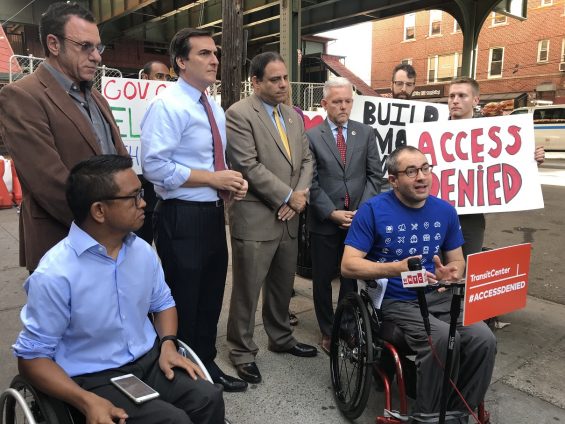Disability Advocates Chris Pangilinan (seated far Left) ; Sasha Blair-Goldensohn (speaking) at an October rally in Astoria (Photo: Tara Law)
July 18, 2018 By Tara Law
The New York City comptroller has called on state lawmakers to increase funding for ADA upgrades in the subway system, noting that 60 city neighborhoods— including 10 in Queens— do not have have an “accessible” subway station.
Comptroller Scott Stringer’s office said yesterday that many neighborhoods are “ADA Transit Deserts”— neighborhoods without an accessible station— in a report yesterday. Jackson Heights, Astoria and Steinway were all listed as neighborhoods where stations are not ADA accessible.
The report noted that the lack of accessibility impacts the disabled, injured, the elderly and families with small children. For these groups, a lack of accessible transport can cut them off from career opportunities and housing, the report said.
The report concluded that the state needs to introduce legislation–such as an $8 billion Transit Bond Act–in the next legislative session to fund accessibility upgrades and other improvements.
The comptroller’s office did praise the MTA’s “Fast Forward” plan, which aims to ensure that there are 50 accessible stations within the next five years. The project will include installing elevators at the Astoria Boulevard (N/W) subway station by 2020.
Over the last year, calls for increased subway accessibility have grown in Astoria.
Disability advocates and a group of mothers held several rallies this fall to call on the MTA to install new elevators along the N/W line.
The protesters said at the time that they were disturbed that the MTA was spending $150 million to renovate four stations— and closing the stations for eight months each— but had decided to forego installing elevators.
The MTA, however, announced in April that it plans to begin installing elevators at the Astoria Boulevard station with closures planned in 2019.
According to Stringer, the Transit Bond Act would help to advance Fast Forward and other accessibility projects.
“For every inaccessible station, there is a New Yorker who can’t get to work, pick up their children from daycare, or visit their doctors,” said Stringer in a statement. “It’s simple – a person’s livelihood should not be dictated by their mobility status, and we must take action immediately to address this crisis. The MTA’s Fast Forward plan is a step in the right direction, but we can and must do more.”
A Transportation Bond Act, Stringer said, could fund accessibility upgrades and other improvements.
People with disabilities already have limited access to the subway, the report argued, and they should not also be left out of transportation upgrades.
“In this iteration, downstate investments must include significant investment for ADA upgrades,” the report said. “With these dollars in place, the MTA can dramatically enhance the reach of the subway system and improve the lives of hundreds of thousands of New Yorkers.”
Meanwhile, MTA spokesperson Shams Tarek said in a statement that the authority is doubling down on its efforts to promote accessibility.
Besides the Fast Forward Plan, the MTA has hired its first accessibility chief and is overhauling the Access-a-Ride network, said Tarek.
“New York City Transit has never been more committed to an accessible transit system than it is right now,” Tarek said.
Jon Orcutt, director of communications and advocacy for transit reform foundation Transit Center, said that his organization is very supportive of the MTA Fast Forward program.
According to Orcutt, the MTA has become much more receptive to accessibility advocates since the tenure of NYCTA President Andrew Byford began this year.
“The MTA didn’t even want to talk about accessibility six months ago,” Orcutt said. “Now the key is to get it financed.”



































